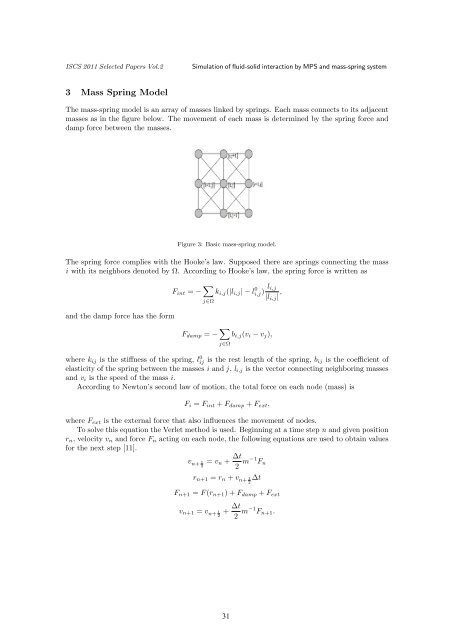RECENT DEVELOPMENT IN COMPUTATIONAL SCIENCE
RECENT DEVELOPMENT IN COMPUTATIONAL SCIENCE
RECENT DEVELOPMENT IN COMPUTATIONAL SCIENCE
You also want an ePaper? Increase the reach of your titles
YUMPU automatically turns print PDFs into web optimized ePapers that Google loves.
ISCS 2011 Selected Papers Vol.2 Simulation of fluid-solid interaction by MPS and mass-spring system<br />
3 Mass Spring Model<br />
The mass-spring model is an array of masses linked by springs. Each mass connects to its adjacent<br />
masses as in the figure below. The movement of each mass is determined by the spring force and<br />
damp force between the masses.<br />
Figure 3: Basic mass-spring model.<br />
The spring force complies with the Hooke’s law. Supposed there are springs connecting the mass<br />
i with its neighbors denoted by Ω. According to Hooke’s law, the spring force is written as<br />
and the damp force has the form<br />
Fint = − ∑<br />
j∈Ω<br />
ki,j(|li,j| − l 0 i,j) li,j<br />
|li,j| ,<br />
Fdamp = − ∑<br />
bi,j(vi − vj),<br />
j∈Ω<br />
where kij is the stiffness of the spring, l 0 ij is the rest length of the spring, bij is the coefficient of<br />
elasticity of the spring between the masses i and j , li,j is the vector connecting neighboring masses<br />
and vi is the speed of the mass i.<br />
According to Newton’s second law of motion, the total force on each node (mass) is<br />
Fi = Fint + Fdamp + Fext,<br />
where Fext is the external force that also influences the movement of nodes.<br />
To solve this equation the Verlet method is used. Beginning at a time step n and given position<br />
rn, velocity vn and force Fn acting on each node, the following equations are used to obtain values<br />
for the next step [11].<br />
v n+ 1<br />
2 = vn + ∆t<br />
2 m−1 Fn<br />
rn+1 = rn + v n+ 1<br />
2 ∆t<br />
Fn+1 = F (rn+1) + Fdamp + Fext<br />
∆t<br />
vn+1 = v 1 n+ +<br />
2 2 m−1Fn+1. 31


